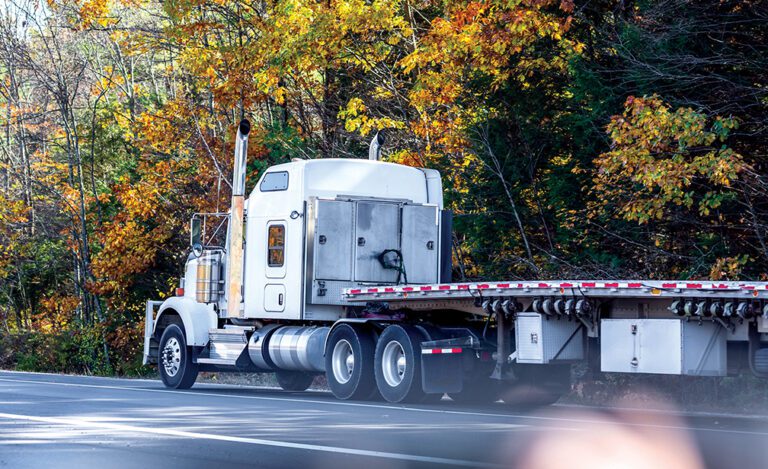The peak season for trucking this year is off to a “muted start,” according to the Cass Freight Index released Oct. 18. The good news for shippers is that they are likely to experience favorable rates through the holiday season.
That news is not good, however, for the truckers who haul that freight.
Cass reported a 1.7% increase in the number of available shipments in September compared to August shipment numbers. Compared with September 2022, however, shipment numbers fell 6.3%. On the expenditures side, shippers spent less — just a 0.2% drop in September compared to August, but 25.4% less than in September 2022. That’s representative of a large drop in freight rates.
“With both the shipments component of the Cass Freight Index and the Cass Truckload Linehaul Index rising sequentially this month, the freight cycle is at least starting to flatten out, with smaller year over year declines,” said Tim Denoyer, vice president and senior analyst at ACT Research, who writes the report for Cass. “We continue to expect the freight cycle to turn once capacity tightens, but early signs of 2024 equipment production suggest that may be a while.”
One issue, Denoyer noted, is the continued growth of private trucking fleets. When rates were reaching record levels in 2021, some manufacturers expanded their private fleets to protect their shipping costs against the rising freight market. Since the backlog for ordered trucks was up to a year, the expansion continued as trucks were delivered even as rates declined.
Manufacturers that haul their own freight aren’t putting those loads out for carriers. Some of those private fleets, depending on their authority type, take backhauls from the market, further reducing available loads for carriers.
“With the U.S. recession consensus of the first half of 2023 giving way to robust growth, and expectations for an improved freight cycle scuttled by private fleet growth, we’re still left in a fairly strong economy,” Denoyer said.
Unfortunately, that strong economy still isn’t filtering down to trucking, as rates remained stagnant for another month in September. The reason? There simply aren’t enough loads to keep all the available trucks running. New truck production continues to be strong, with over 22,000 trucks delivered in the U.S. in September, the eighth consecutive month in which sales have exceeded 20,000.
Another reason is that freight levels have not fully rebounded, despite the strong economy. Once the stimulus money the government poured into the economy during the COVID-19 pandemic began to run out, consumer spending slowed, with retailers and manufacturers adjusting their inventory levels downward (destocking) to compensate.
This can be seen in the Loads per Truck numbers posted on the DAT Freight and Analytics Trendlines page. DAT is the nation’s largest load board, with postings of over 448 million loads and trucks annually. Note that the loads posted on the board aren’t always hauled by trucks posted there, because carriers do not have to post available trucks on the board to get loads. While some do post truck availability on the board and hope for offers, most simply find a load they want and deal with the broker or shipper, without posting their truck at all.
Comparing the number of available loads to trucks does, however, provide an indication of the overall supply/demand balance in the industry. When load numbers (demand) fall and/or truck (supply) numbers rise, rates fall because there is more competition for available freight.
According to DAT, the van load to truck ratio fell by 1.7% from August and by 21.3% from September of 2022. DAT reported there were 2.78 loads posted on its board for each truck posted in September. A year ago in September 2022, that number was 3.54, and it was 6.32 in September 2021, when rates were much better.
Van spot rates averaged out to $2.11 per mile in September, about three cents higher than the August average. In comparison, average van contract rates rose to $2.58 per mile.
The temperature-controlled (reefer) ratio was a little better at 3.43 loads per posted truck, but that too was down from 6.33 in September 2022 and 13.5 in September 2021. National average reefer spot rates rose by two cents per mile to $2.52 from August rates. Contract rates rose for the third consecutive month to $3.00 per mile average.
The flatbed segment seems to be better yet, with 6.94 loads posted for each truck posted, compared to 13.3 in September 2022 and 47.9 back in September 2021. National average flatbed spot rates ended their five-month slide, rising a penny to $2.51 per mile. Contract rates, which have fallen steadily since November of last year, fell another penny to $3.12 per mile.
The news may be getting better for the flatbed segment of the industry, according to a recent report from the U.S. Census Bureau. The report stated that new orders for manufactured goods rose by $6.7 billion in August, higher than market expectations. Since manufacturing accounts for about 60% of flatbed demand, the news bodes well for a rise in available flatbed loads in the near future.
The recently released “Holiday Report” from Motive, which uses the number of visits by trucks equipped with Motive communications or telemetrics products to retail warehouses to predict economic trends, began with a “big picture.”
“In 2023, we’ve experienced reduced consumer demand and an oversupply of capacity, which have shrunk and restrained the market. It’s expected that the trend will continue into Q4 and early 2024, so carriers should adjust their plans accordingly,” wrote Hamish Woodrow, head of strategic analytics for Motive.
The Motive release predicts the current contraction of the trucking market will continue into next year and warns that operational efficiency will be the key to carriers having “a happy new year.”
The strength of the economy is a positive, but there are still too many available trucks — and more are on the way. Experts claim trucking is poised to begin its next upcycle, but when that will happen is anyone’s guess.
Cliff Abbott is an experienced commercial vehicle driver and owner-operator who still holds a CDL in his home state of Alabama. In nearly 40 years in trucking, he’s been an instructor and trainer and has managed safety and recruiting operations for several carriers. Having never lost his love of the road, Cliff has written a book and hundreds of songs and has been writing for The Trucker for more than a decade.









“Fairly strong economy.” I’ll have some of what they are smoking.
The problem today are the so called experts form these opinions on the lies they are told. I can tell you what I am seeing and hearing and it’s not a “fairly strong economy.”
I have been around a trucking family all my life from my grandfather to my uncle’s to my father then to me now my son drives the 43 yrs I been driving my own truck hauling every kind of trailer in my life to now I just pull my reefer trailer I can remember hauling into hunts point market for yrs I was$50 to $75 to unload go to giant or Safeway or wakfern in NJ was never over $60 to unload now days go to giant it’s not less then $300 for unloading to high $450 for unloading them you sit there for five hours or more crazy I am glad one more yr I am done with this mess and let’s not talk about tags use to be $350 a yr now there close to $1900. and insn. is sky high theresto many hands in the pot of trucking now days and to many want to be truckers
Strong economy? Currently?? Somebody’s drinking the kool-aid from the left.